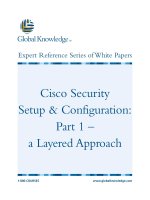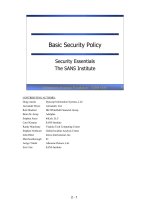Tài liệu NETWORK SECURITY BY DAVID G.MESSERSCHMITT ppt
Bạn đang xem bản rút gọn của tài liệu. Xem và tải ngay bản đầy đủ của tài liệu tại đây (53 KB, 5 trang )
Copyright 1999 University of California
Page 1 8/18/99
Network Security
by David G. Messerschmitt
Supplementary section for Understanding Networked Applications: A First Course
, Morgan
Kaufmann, 1999.
Copyright notice:
Permission is granted to copy and distribute this material for educational pur-
poses only, provided that this copyright notice remains attached.
By its very nature, a public network is a security risk, as it opens up access to each connected host
to everybody (see Chapter 13). Fortunately, there are measures that can be taken to mitigate these
risks. Both the risks, and the measures taken to counter them are dependent on an understanding
of the network architecture presented earlier in this chapter.
Secure and Insecure Authentication
One key to protecting a host is access control and associated authentication of users. Unfortu-
nately, some simple authentication approaches commonly used are insecure. A common approach
is to ask a user to supply a password, which can be captured in transit unless the entire session is
encrypted. Alternatively, the IP address of a host is sometimes used to authenticate it. An intruder
who gains physical access to a network (or can surreptitiously install a program in a host con-
nected to a network) can monitor network traffic. This sniffing attack can uncover valuable infor-
mation, such as the IP address of hosts or user passwords. It is possible for an attacker to
masquerade as a different host by spoofing an IP address, making it appear that packets are origi-
nating from another host. Authentication based on a shared secret or certificate as was described
in Chapter 13 is much more secure.
Servers sometimes authenticate another host by matching its domain name against its IP address
by making a query to the domain name system. Unfortunately, the DNS is itself insecure, and thus
should not be trusted. Also, the information sent among DNS zones can be sniffed, uncovering
potentially valuable information such as a list of domain names and IP addresses internal to an
intranet. These examples illustrate that there many subtle security issues on a public network. On
the other hand, a public network actually benefits from many attempts at penetration, which
increase the likelihood that subtle security flaws are discovered and repaired.
Security Flaws in Public Servers
Many Internet hosts must offer publicly available servers, for example to send and receive email
and provide Web services. Not infrequently these servers have security flaws. Once external
access to these servers is allowed, attackers can exploit them. Web servers are especially vulnera-
ble given the capability to extend them—using a common gateway interchange (CGI)—allowing
the HTTP server to invoke an arbitrary program or script. Sometimes ordinary users add CGI
extensions, and they sometimes have security flaws.
Firewalls and Packet Filtering
Applications in an intranet can be publicly available without compromising the security of other
applications or hosts by adding firewalls. As described in Chapter 13, firewalls create a trusted
enclave that is partially isolated from the global Internet (less Draconian than physically isolating
the enclave). They enforce security policies such as:
Copyright 1999 University of California
Page 2 8/18/99
• Access control. Limit access from outside the enclave to a specific list of hosts (or whole sub-
networks). Alternatively a specific list of hosts can be excluded.
• Application control. Restrict services and applications available to users outside the enclave,
or access of internal users outside the enclave, by restricting the transport protocols that can
pass through the firewall (usually to TCP), the acceptable addresses, and applications.
Firewalls must be continually monitored by system administrators. Suspicious activity can be
logged, and system administrators alerted. It is common to put public servers requiring unfettered
access to the Internet outside the trusted enclave, hoping to isolate any security problems caused
by these servers from penetrating the enclave.
Several common configurations for firewalls [Gar96] are shown in Figure 1 The elements of
these configurations include:
• The firewall acts as a packet filter, examining all IP packets and passing only those meeting
specific criteria, such as destination, or running specific transport protocols (like TCP), or
supporting specific applications.
Figure 1. Several typical firewall configurations.
Firewall
Bastion
hosts
Internal
hosts
Global Internet
Second
firewall
Public hosts
Protected enclave
Firewalls Inhibit Innovation
One key source of success in the Internet was keeping the network simple, and allowing addi-
tional capabilities (new transport protocols or applications) to be added. It has traditionally
been possible for a single programmer to make an innovation and distribute it widely in very
short order.
Sadly, this capability is lost where firewalls are added. Since firewalls specifically limit proto-
cols and applications, new innovations are available to users within a trusted enclave only
when the firewall is upgraded. Since firewalls generally incorporate only standardized proto-
cols and applications, the practical impact of this is to greatly increase the importance of stan-
dardization activities like the IETF (see "Internet Engineering Task Force (IETF)" on page
190). Strong security is invasive to users and organizations in many ways.
Copyright 1999 University of California
Page 3 8/18/99
• Bastion hosts are special hosts within the enclave. If there are bastion hosts, the firewall only
allows IP packets to pass to and from the bastion hosts (other packets are blocked).
• Public hosts are special hosts outside the enclave. This is where, for example, a public HTTP
server might run.
With a single firewall, incoming traffic may be restricted to specific hosts, and some services may
be blocked, but internal hosts are given unfettered access to the outside. It may be feasible for
intruders to set up tunneling of one application (supposedly prohibited) within another (that is
allowed). For example, a TCP connection may appear to the firewall to be implementing telnet
(which is allowed) but the telnet packets have some other forbidden application encapsulated
within them.
When bastion hosts are added, then the firewall passes only packets destined for or originating
from the bastions. Bastion hosts provide external services, such as email, and can execute proxies
for the benefit of applications running on non-bastion hosts. (A proxy is a program that acts on
behalf of another.) This limits the damage due to insecure servers and tunneling.
Finally, in the double-firewall architecture, a second firewall interior to the bastion hosts provides
an additional layer of protection. For example, an intruder gaining access to the bastion host can’t
penetrate to hosts within the interior enclave. This architecture is especially common with extra-
nets, where the bastions provide extranet functions and the interior firewall provides additional
protection for sensitive internal activity.
Firewalls are also used to compartmentalize an organization. For example, access policies may
reasonably prohibit the engineering department from accessing human resources servers, and fire-
walls can enforce such policies. Recall, however, that firewalls are effective only as part of a secu-
rity system, which should include confidentiality, authentication, and operational vigilance.
Where to Use Encryption and Authentication
The encryption techniques described in Chapter 13 assure confidentiality, but the question arises
“where to use encryption?”. Chapter 13 incorporated encryption into applications (such as SET,
PGP, and SHTTP). This is the most secure approach, but places additional burdens on application
developers and is relatively invasive to users (who must deal with passwords, secrets, etc.).
Armed with an understanding of the network, there are other possibilities that trade a bit lower
security for less intrusiveness. They differ as to the protocol layer where authentication and
encryption is implemented, and also position in the network topology:
• Firewall-to-firewall. An organization frequently has two or more geographically separated
locations, each with a protected enclave. Confidential internal communication among loca-
tions can be achieved using leased dedicated facilities (a private network). An extranet—a pri-
vate network embedded within the public Internet—is less expensive. This can be achieved
using encrypted semi-permanent IP connectivity among firewalls, which do the encryption
and decryption and authenticate one another to avoid spoofing attacks.
• Host-to-host. Authentication of hosts and encryption of IP packet payloads can be performed
at the IP layer. The IETF is standardizing these capabilities (called IPsec).
• Process-to-process. One could argue that authentication and encryption should be provided as
a normal part of a process-to-process communication service. Secure sockets layer (SSL) was
originally proposed by Netscape to provide authentication and confidentiality in Web
browser-to-server connections, but is available for any TCP process-to-process communica-
Copyright 1999 University of California
Page 4 8/18/99
tion.
• Link-by-link. The previous approaches encrypt only (IP or TCP) packet payloads. When IP
packet headers aren’t encrypted (because network routers must examine them to do packet
forwarding) an attacker can do traffic analysis; that is, see who is communicating with whom
and the amount of traffic. This privacy concern can be redressed by encryption and decryption
on communication links between packet switches (including packet headers). Internal to the
switch, packet headers must not be encrypted so packets can be forwarded, but an intruder
monitoring the communication link would gain no information about packet content, source,
or destination. Link encryption is particularly attractive on wireless communication links
(which are relatively easy to monitor).
These possibilities are not exhaustive, but serve to illustrate a range of possibilities.
Discussion
D1 Discuss the increasing importance of security in the Internet, in light of its history as a
research network (see "The Origins of the Internet" on page 311).
D2 The firewall presumes that users internal to a protected enclave don’t present a threat.
Discuss situations where this assumption may be violated.
D3 Discuss the role of operational vigilance on security. What should network operations be
on the lookout for? How should they respond to security problems they encounter?
Review
Network security is a major issue, especially in the Internet which arose in a relatively benign and
trusted environment. Thus, many legacy applications use low-security techniques, such as basing
authentication on source address. Firewalls provide a focus point (at the boundary of a trusted
enclave) to enforce security policies, such as control of access, protocols, and applications. Using
firewall-to-firewall encryption and authentication, virtual private networks can be embedded
within the global public Internet.
Concepts
Security:
• Firewalls
• Encryption
Exercises
E1. Discuss the access control mechanisms that you have observed in:
a. A local bank branch
b. A military base
c. A scheduled airline
E2. Give two real-world analogies to each of the following;
a. A firewall
b. A bastion host
c. A public host outside a firewall
Copyright 1999 University of California
Page 5 8/18/99
E3. Give three example applications where a traffic analysis might be helpful to an intruder in gleaning
information that should be private. Describe how the information obtained might be helpful to the
intruder.









